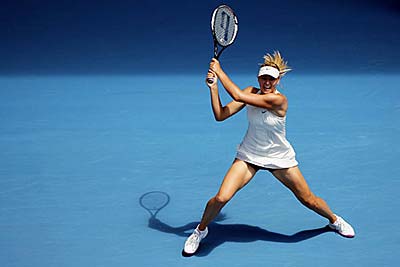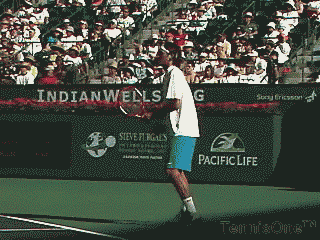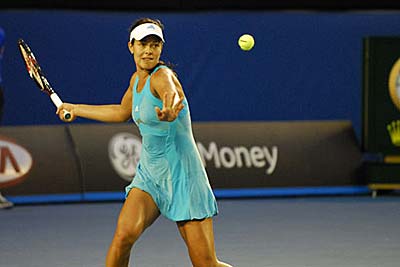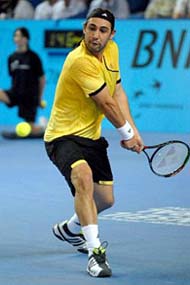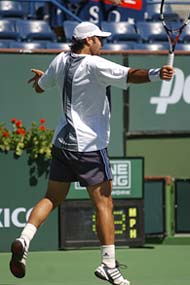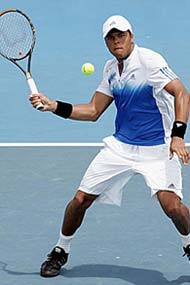|
TennisOne Lessons Aces and Faults at the Australian Open Paul Fein Last year Mats Wilander, the thoughtful seven-time Grand Slam champion, derided Maria Sharapova as “just a thoughtless pounder of the ball.” This year Sharapova showed at the Australian Open what a difference a healthy shoulder and a revitalized serve make. The 6’2” Russian won 89% of her first serve points against No. 4 Ana Ivanovic in the final, 83% against No. 3 Jelena Jankovic, 68% against No. 1 Justine Henin, and 86% against former No. 1 Lindsay Davenport, the greatest female service returner in history.
Sharapova achieved these impressive stats in part because she intelligently mixed up the speed, placement and spin of her serves. Her most devastating serves were sliced wide in the deuce court. These serves pulled opponents off the court so she could easily hit their returns into the open court to force errors or produce outright winners. During her awesome 6-4, 6-0 victory over Henin, Sharapova won the point on 82% (14 of 17) of her net approaches. She also won 80% (8 of 10) at net against Ivanovic and a stunning 94% (16 of 17) against Jankovic. Besides adept volleying and smashing, Sharapova showed versatility by hitting some down-the-line, one-handed, slice approach shots with a touch of nasty sidespin. These accurate approaches bounced low and made passing shots highly difficult. Few women pros have mastered this essential and effective shot. Strategically, Sharapova smartly forced Henin into crosscourt backhand exchanges where she overpowered the Belgium’s elegant but weaker one-handed shot. Against the wild and erratic Ivanovic, Sharapova played aggressively, but also patiently. Most of the time, her solid, high-percentage tennis elicited plenty of forced and unforced (33) errors from Ivanovic, a low-percentage shotmaker that day. Martina Navratilova accurately summed up why Sharapova won her third major title without losing a set despite a brutal draw: “She’s serving big, returning big, moving well, and the biggest surprise is all the variety in her game.” Novak Djokovic Has Clearly Arrived In my new book, Tennis Confidential II: More of Today’s Greatest Players, Matches, and Controversies, I asserted that during his sensational, record-amassing 2004-07 reign, Roger Federer was fortunate not to face highly confident, experienced and outstanding multi-Slam champions, except for Nadal who until 2007 was highly proficient at Slam events only on clay. Instead, his stiffest competition came from an aging Agassi with a chronic back injury, a middleweight counterpuncher Hewitt, a flawed Roddick, a mentally fragile Safin, and an emerging Djokovic. After his tour de force at the Australian Open, where he dropped only one set while beating Jo-Wilfried Tsonga 4-6, 6-4, 6-3, 7-6 to capture his first Grand Slam title, “The Djoker” has clearly arrived. Let’s analyze how Novak Djokovic did it, and why I believe he will win several more major titles.
While great rivalries enthrall us, new faces and rising stars fascinate us. Let’s evaluate the two most intriguing ones. Ana Ivanovic
This charming Serbian beauty has a powerful, classic serve, a devastating forehand, an improving backhand, and a slimmer body (honed by new fitness trainer Scott Byrnes) that has helped her movement, still a liability. Thus far the 6’1", 20-year-old has proved she can beat the elite regularly − last year she notched 14 wins over top 10-ranked opponents, second only to Justine Henin. Unfortunately, she also falters when it matters most: in Grand Slam finals. During her 6-1, 6-2 French Open final against Henin last year, she was overcome by the occasion and so nervous she could hardly hit a ball in the court. She insists she learned from that debacle. In the 7-5, 6-3 Oz Open final, Ivanovic was less nervous but so overanxious and reckless that she seemingly had no plan and committed 33 unforced errors (compared to 15 for Sharapova) and many by several feet. Studying the video of that match should enlighten her immensely about how to win major titles: stay calm, and attack but also play percentage tennis. Jo-Wilfried Tsonga This decade the Australian Open has given us surprise finalists Arnaud Clement, Rainer Schuettler, Marcos Baghdatis and Fernando Gonzalez and unexpected champion Thomas Johansson, all of whom then faded a little or lot. However, the charismatic, 22-year-old Frenchman, barring injuries that have impeded his career, appears likely to stay in the top 10 and contend strongly at Grand Slam tournaments for at least the next five years. Tsonga’s most lethal weapons are an explosive serve − that racked up 100 aces and committed only 15 doublefaults during the fortnight − a powerful forehand, athleticism at net, and the ability to handle big-match pressure. Despite being a solid underdog against Djokovic, he hit fearlessly to break his foe’s serve twice to take the opening set 6-4. Listed at 200 pounds and 6’2”, Tsonga would improve his stamina (and probably court coverage, too) if he dropped another 5-8 pounds. He travels with a trainer and reportedly has improved his core strength considerably. It was a kind and gentle 71 degrees F. for the evening final, but will he last for five grueling sets when the temperature is 20 degrees hotter?
Parting Shots The eagerly awaited Hewitt-Baghdatis third round match began at 11:47 p.m., and the five-set marathon ended at 4:33 a.m. Nothing − not pressure from TV sports executives or poor early evening match scheduling − justifies starting a best-of-five-set match later than 10 p.m. It’s a gross injustice for world-class players to be playing when they would normally be sleeping. That said, the best argument against horrendous No-Ad scoring in singles or doubles was the terrific, fluctuating fifth game of the fifth set of the Hewitt-Baghdatis duel that had eight deuces and featured brilliant shotmaking. During that memorable game, ever-combative Hewitt shouted toward his friend’s box, “I’m not going down!” He didn’t. Although 18-year-old Donald Young went down in a close four-setter to burly German Michael Berrer (who lost decisively to Andy Roddick), he still remains America’s brightest hope for the next decade. He’s becoming a smarter player but needs to hit his backhand deeper.
As the pace of backcourt rallies gets faster and faster, the advantage of running around backhands to smack forehands decreases. When Fernando Gonzalez ran into his backhand corner but didn’t hit forehands accurately or hard enough, Hung-Taik Lee, an unheralded Korean, frequently belted backhands down the line into the open court for a winner or a forced Gonzalez error. The once-phenomenal careers of the Williams sisters appear to be at a crossroads. Still bedeviled by serve and forehand technique flaws, Venus succumbed 7-6, 6-4 to Ivanovic. Serena, despite being in relatively good shape, lacked both her usual ferocity and power while losing tamely 6-3, 6-4 to Jelena Jankovic. That marked Serena’s fourth straight Grand Slam quarterfinal defeat. Will the Williams sisters ever win another Grand Slam title? And if they don’t, which American will, because for the first time since 1973 no American reached the semifinals of the men’s and women’s singles and doubles and mixed doubles at the Australian Open? Hawk-Eye line-calling technology is terrific, but Player Challenges are terrible. After a succession of incorrect line calls were not challenged, astute TV analyst Mary Carillo sarcastically said: “So the idea that we should get as many calls right as possible is still a bad idea. Is that how it goes? The point is that the technology could have called it [right].” If Hawk-Eye immediately showed all close line calls to the chair umpire and on the stadium screen, then all line calls would be right all the time. Martin Johnson gave readers of The Telegraph (UK) the best description yet of the Sharapova Serving Ritual: “Before every Sharapova serve, she wanders down to the ballboys to collect her ammunition, one of which she carefully deposits inside her dress, thus giving her the look of someone with an inoperable hip tumor. She then stares at her racquet, returns to the baseline for some ball bouncing, before carefully adjusting her hair on both sides of her ears. A couple more bounces and, with her opponent having had more than enough time to nip out for a bathroom break, Maria is finally ready to go.” Your comments are welcome. Let us know what you think about Paul Fein's article by emailing us here at TennisOne.
Award-winning tennis writer Paul Fein's book, Tennis Confidential: Today's Greatest Players, Matches, and Controversies , published by Brassey's, Inc., was listed No. 1 among tennis books by Amazon.com and BN.com. Information about the book and how to order it can be found at: www.tennisconfidential.com . His second book, You Can Quote Me on That: Greatest Tennis Quips, Insights, and Zingers , was published by Potomac Books, Inc. (formerly Brassey's, Inc.) in February 2005. For more information, visit www.tennisquotes.com His third book, Tennis Confidential II: More Greatest Players, Matches, and Controversies, will be published in March, 2008. |

